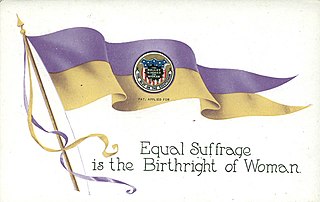
The National American Woman Suffrage Association (NAWSA) was an organization formed on February 18, 1890, to advocate in favor of women's suffrage in the United States. It was created by the merger of two existing organizations, the National Woman Suffrage Association (NWSA) and the American Woman Suffrage Association (AWSA). Its membership, which was about seven thousand at the time it was formed, eventually increased to two million, making it the largest voluntary organization in the nation. It played a pivotal role in the passing of the Nineteenth Amendment to the United States Constitution, which in 1920 guaranteed women's right to vote.

Carrie Chapman Catt was an American women's suffrage leader who campaigned for the Nineteenth Amendment to the United States Constitution, which gave U.S. women the right to vote in 1920. Catt served as president of the National American Woman Suffrage Association from 1900 to 1904 and 1915 to 1920. She founded the League of Women Voters in 1920 and the International Woman Suffrage Alliance in 1904, which was later named International Alliance of Women. She "led an army of voteless women in 1919 to pressure Congress to pass the constitutional amendment giving them the right to vote and convinced state legislatures to ratify it in 1920". She "was one of the best-known women in the United States in the first half of the twentieth century and was on all lists of famous American women."

The National Woman's Party (NWP) was an American women's political organization formed in 1916 to fight for women's suffrage. After achieving this goal with the 1920 adoption of the Nineteenth Amendment to the United States Constitution, the NWP advocated for other issues including the Equal Rights Amendment. The most prominent leader of the National Woman's Party was Alice Paul, and its most notable event was the 1917–1919 Silent Sentinels vigil outside the gates of the White House.

Brenda Ueland was an American journalist, editor, freelance writer, and teacher of writing. She is best known for her book If You Want to Write: A Book about Art, Independence and Spirit.

Doris Stevens was an American suffragist, woman's legal rights advocate and author. She was the first female member of the American Institute of International Law and first chair of the Inter-American Commission of Women.

Emma Smith DeVoe was an American women suffragist in the early twentieth century, changing the face of politics for both women and men alike. When she died, the Tacoma News Tribune called her Washington state's "Mother of Women's Suffrage".

Anna Dickie Olesen was an American politician from the state of Minnesota who was the first woman to be nominated by a major party for the United States Senate.

The Minnesota Woman Suffrage Association (MWSA) operated from 1881 to 1920. The organization was part of the broader women's suffrage movement in the United States and it sought to secure the right of women to vote in Minnesota. Its members organized marches, wrote petitions and letters, gathered signatures, gave speeches, and published pamphlets and broadsheets to compel the Minnesota Legislature to pass legislation that recognized their right to vote. As a result of the movement's efforts, the legislature ratified the Nineteenth Amendment to the United States Constitution in 1919, which prohibited the denial of citizens to vote based on sex.

Julia Bullard Nelson (1842–1914) was an American temperance and women's rights activist from Red Wing, Minnesota. Following the death of her husband and their only child, she bravely headed south to Texas, in 1869, to teach former slaves in U.S. government-backed Freedmen's Bureau schools. Nelson spent the summers of the 1870s and 1880s in Minnesota, where she emerged as a state and national leader in the movement for women's suffrage and the temperance campaign against alcohol use.

Elsie Hill was an American suffragist, as were her sisters Clara and Helena Hill.

Women's suffrage was established in the United States on a full or partial basis by various towns, counties, states and territories during the latter decades of the 19th century and early part of the 20th century. As women received the right to vote in some places, they began running for public office and gaining positions as school board members, county clerks, state legislators, judges, and, in the case of Jeannette Rankin, as a member of Congress.
First Unitarian Society of Minneapolis is a non-theistic humanist community and member of the Unitarian-Universalist Association located at 900 Mount Curve, Minneapolis, Minnesota. Once led by the influential minister John H. Dietrich who is known as the "Father of Religious Humanism," First Unitarian Society of Minneapolis is considered in today's terminology the "birthplace of Congregational Humanism."

The Minnesota Woman Suffrage Memorial is a permanent feature on the grounds of the Minnesota State Capitol in Saint Paul. It commemorates the women’s suffrage movement in the state and 25 women whose achievements were important to the Minnesota Woman Suffrage Association (MWSA). The memorial was designed by architects Ralph Nelson, Raveevarn Choksombatchai, and Martha McQuade.

Sarah Burger Stearns was a social reformer and a leader in the woman's suffrage movement in the U.S. state of Minnesota. She co-founded the Minnesota Woman Suffrage Association and served as its first president.

Sarah Tarleton Colvin was an American nurse and women's rights advocate who served as the national president of the National Woman's Party in 1933. Jailed for her activism while picketing the White House in 1918 and 1919, Colvin later wrote her autobiography about the suffrage movement and her nursing career.

This is a timeline of women's suffrage in Montana. The fight for women's suffrage in Montana started early, before Montana became a state. In 1887, women gained the right to vote in school board elections and on tax issues. In the years that followed, women battled for full, equal suffrage, which culminated in a year-long campaign in 1914 when they became one of eleven states with equal voting rights for most women. Montana ratified the Nineteenth Amendment on August 2, 1919 and was the thirteenth state to ratify. Native American women voters did not have equal rights to vote until 1924.

Attempts to achieve women's suffrage in Montana started while Montana was still a territory. The Women's Christian Temperance Union (WCTU) was an early organizer that supported suffrage in the state, arriving in 1883. Women were given the right to vote in school board elections and on tax issues in 1887. When the state constitutional convention was held in 1889, Clara McAdow and Perry McAdow invited suffragist, Henry Blackwell, to speak to the delegates about equal women's suffrage. While that proposition did not pass, women retained their right to vote in school and tax elections as Montana became a state. In 1895, National American Woman Suffrage Association (NAWSA) came to Montana to organize local groups. Montana suffragists held a convention and created the Montana Woman's Suffrage Association (MWSA). Suffragists continued to organize, hold conventions and lobby the Montana Legislature for women's suffrage through the end of the nineteenth century. In the early twentieth century, Jeannette Rankin became a driving force around the women's suffrage movement in Montana. By January 1913, a women's suffrage bill had passed the Montana Legislature and went out as a referendum. Suffragists launched an all-out campaign leading up to the vote. They traveled throughout Montana giving speeches and holding rallies. They sent out thousands of letters and printed thousands of pamphlets and journals to hand out. Suffragists set up booths at the Montana State Fair and they held parades. Finally, after a somewhat contested election on November 3, 1914, the suffragists won the vote. Montana became one of eleven states with equal suffrage for most women. When the Nineteenth Amendment was passed, Montana ratified it on August 2, 1919. It wasn't until 1924 with the passage of the Indian Citizenship Act that Native American women gained the right to vote.

Marguerite Milton Wells (1872–1959) was an American suffragist and social reformer. She served as president of the Minnesota League of Women Voters and president of the National League of Women Voters.
Ethel Edgerton Hurd (1845–1929) was a physician, a social reformer and a leader in the woman's suffrage movement in the U.S. state of Minnesota. She was a founder of the Political Equality Club of Minneapolis and the Scandinavian Woman Suffrage Association, and a member of the executive board of the Minnesota Woman Suffrage Association. For her activities, she was named to the national roll of honor of the League of Women Voters.

The women's suffrage movement in the U.S. state of Minnesota began the mid-1800s and culminated in the ratification of the Nineteenth Amendment by the state's legislature in 1919. The amendment, which prevents states from denying women the right to vote, was officially adopted and added to the Constitution of the United States in 1920.

















